Formica neorufibarbis
| Formica neorufibarbis | |
|---|---|

| |
| Scientific classification | |
| Kingdom: | Animalia |
| Phylum: | Arthropoda |
| Class: | Insecta |
| Order: | Hymenoptera |
| Family: | Formicidae |
| Subfamily: | Formicinae |
| Tribe: | Formicini |
| Genus: | Formica |
| Species: | F. neorufibarbis |
| Binomial name | |
| Formica neorufibarbis Emery, 1893 | |
| Synonyms | |
| |
This insignificant-appearing ant is a record-holder. It occupies a territory much greater than that of any other Nearctic species of the fusca group. It also holds the elevational record for the Nearctic ant fauna: 14,269 ft. on Mt. Evans in Colorado (Gregg, 1963). Similarly it holds the altitudinal record in Nevada: 12,160 ft. on Boundary Peak. Formica neorufibarbis is a common, widely distributed species. Nests may be found under stones or logs and in rotten logs and stumps in areas of rocky sand or loam.
Identification
This species has few erect hairs, the gaster is polished and strongly shining, the surface is little hidden by sparse pubescence. The metasternal process is poorly developed, but is usually surrounded by erect hairs. The area between the anterior edge of the eye and the mandible has elongate punctures, which are often difficult to see unless the surface is held obliquely and the light is directed from the side. The shiny gaster usually suggests the neorufibarbis species complex, the other characters, especially the lack of hairs on the ventral surface of the head and dorsum of the petiole, together with the elongate punctures on the gena, confirm the identification. (Mackay and Mackay 2002)
Keys including this Species
- Key to Polyergus Species
- Key to US Polyergus species
- Key to Nearctic Formica fusca group males
- Key to Nearctic Formica fusca group queens
- Key to Nearctic Formica fusca group workers
- Key to New England Formica
Distribution
An enormous triangle from western Alaska on the Bering Strait and the Mackenzie Delta (on the border of the Arctic Ocean) to an apex on Newfoundland; thence southwestward to New Mexico, Arizona, California and into northern Mexico; its base extends northward along the Pacific Coast to southern and central Alaska.
Latitudinal Distribution Pattern
Latitudinal Range: 69.333333° to 29.23848°.
| North Temperate |
North Subtropical |
Tropical | South Subtropical |
South Temperate |
- Source: AntMaps
Distribution based on Regional Taxon Lists
Nearctic Region: Canada, United States (type locality).
Neotropical Region: Mexico.
Distribution based on AntMaps
Distribution based on AntWeb specimens
Check data from AntWeb
Countries Occupied
| Number of countries occupied by this species based on AntWiki Regional Taxon Lists. In general, fewer countries occupied indicates a narrower range, while more countries indicates a more widespread species. |

|
Habitat
In New Mexico (Mackay and Mackay 2002) - Sagebrush, grasslands, pinyon-juniper, up to spruce and aspen, fir, riparian cottonwood forests and ponderosa pine forests.
Biology
"This ant represents a characteristic element of the boreal coniferous forest .... It is the Formica which endures the most severe climate in North America and one of the few ants that can breach the boundary of the tundra .... This ant which is very timid feeds on honeydew and dead arthropods. It seems to gather little from flowers" (translation from Francoeur, 1973).
Bernstein (1976) reported that 85% of the food collected is liquid from plants, mostly flowers. Regardless of abundance of food, all foraging ceases as soon as the brood is mature. The brood is reared quickly, an adaptation to a short summer. The smaller workers are nearly black; therefore they warm up earlier in the day. A larger body tends to heat up more slowly and a redder color probably reflects more solar radiation than would a blacker color. "Color and size differences ... enable each colony to utilize a greater range of environmental conditions for foraging than if they were of a single size and color."
For New Mexico (Mackay and Mackay 2002) - Brood was found in nests in July and August, reproductives were in nests in August. The diurnal foragers are found in chollas (Opuntia sp.). This species is enslaved by other species of Formica (Formica adamsi alpina) and by Polyergus mexicanus.
Nevada, Wheeler and Wheeler (1986) - Our 104 records represent 51 localities scattered statewide. The elevational range is 5,000-12,160 ft.; 79% were above 8,000 ft. and 51% were above 10,000 ft. One record was from the Pinyon-Juniper Biome, 22 were in the Coniferous Forest Biome, 9 in the ecotone above it, and 42 from the Alpine Biome. Thirty-three colonies nested under stones; 27 were in and/or under rotten wood lying on the ground or partially buried and 1 was in the root system of a phlox-like plant. The workers were fast and aggressive and the bite was annoying. We found 1 colony enslaved by Formica aserva.
Host for Slave-makers
This species is enslaved by the following slave-makers:
- This species is a host for the ant Formica adamsi (a temporary parasite) (Mackay and Mackay 2002).
Association with Other Organisms
 Explore: Show all Associate data or Search these data. See also a list of all data tables or learn how data is managed.
Explore: Show all Associate data or Search these data. See also a list of all data tables or learn how data is managed.
- This species is a mutualist for the aphid Aphis asclepiadis (a trophobiont) (Addicott, 1979a; Saddiqui et al., 2019) (as Formica neorufibarbis gelida).
- This species is a mutualist for the aphid Aphis salicariae (a trophobiont) (Addicott, 1979a; Saddiqui et al., 2019) (as Formica neorufibarbis gelida).
- This species is a mutualist for the aphid Aphis varians (a trophobiont) (Addicott, 1979a; Saddiqui et al., 2019) (as Formica neorufibarbis gelida).
- This species is a mutualist for the aphid Rhopalosiphum nymphaeae (a trophobiont) (Jones, 1927; Saddiqui et al., 2019).
- This species is a host for the cricket Myrmecophilus nebrascensis (a myrmecophile) in United States.
- This species is a host for the eucharitid wasp Eucharis sp. (a parasitoid) (Quevillon, 2018) (multiple encounter modes; direct transmission; transmission outside nest).
- This species is a prey for the Microdon fly Microdon albicomatus (a predator) (Quevillon, 2018).
- This species is a prey for the Microdon fly Microdon piperi (a predator) (Quevillon, 2018).
Castes
Worker
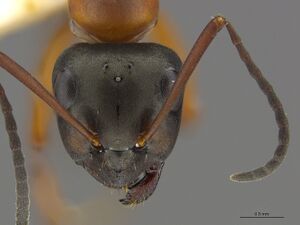 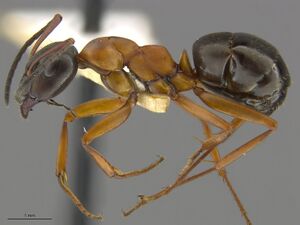 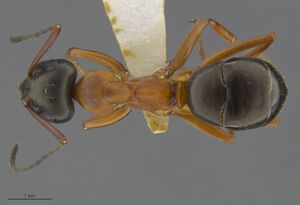 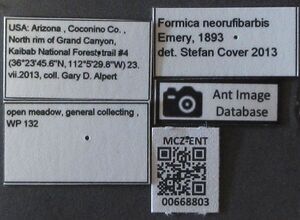
| |
| Worker. . | Owned by Museum of Comparative Zoology. |
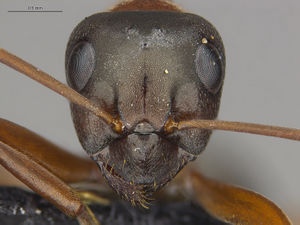 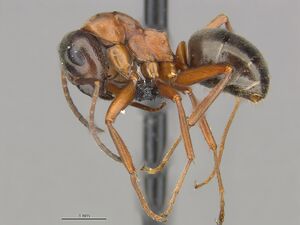 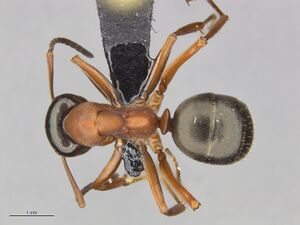 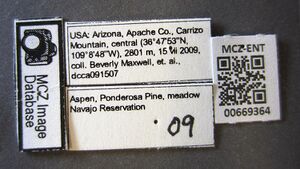
| |
| Worker. . | Owned by Museum of Comparative Zoology. |
Images from AntWeb
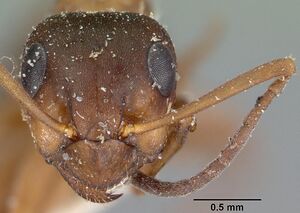 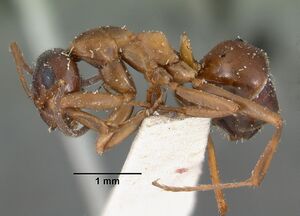 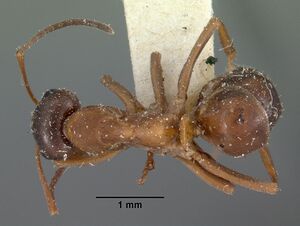 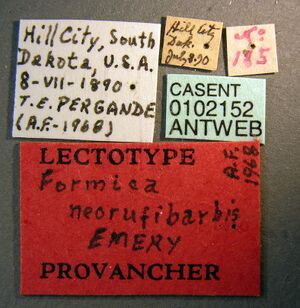
| |
| Lectotype of Formica neorufibarbis. Worker. Specimen code casent0102152. Photographer April Nobile, uploaded by California Academy of Sciences. | Owned by MSNG, Genoa, Italy. |
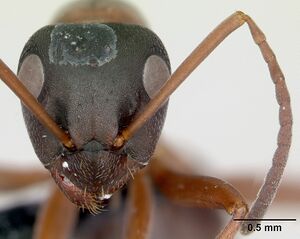 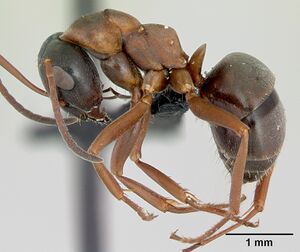 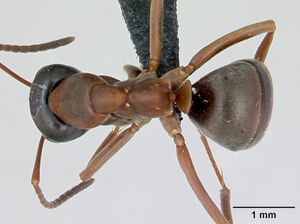 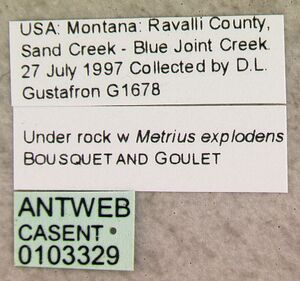
| |
| Worker. Specimen code casent0103329. Photographer April Nobile, uploaded by California Academy of Sciences. | Owned by CAS, San Francisco, CA, USA. |
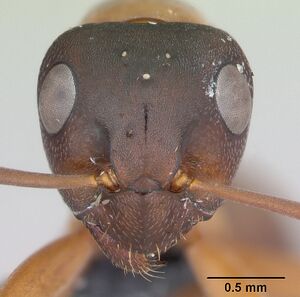 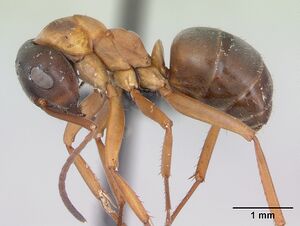 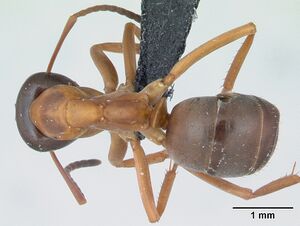 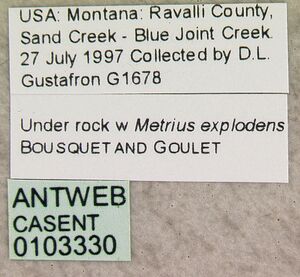
| |
| Worker. Specimen code casent0103330. Photographer April Nobile, uploaded by California Academy of Sciences. | Owned by CAS, San Francisco, CA, USA. |
Queen
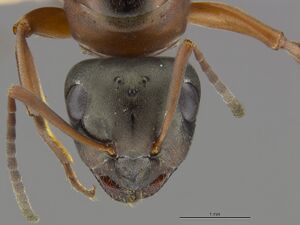 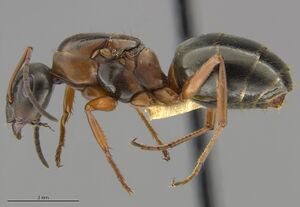 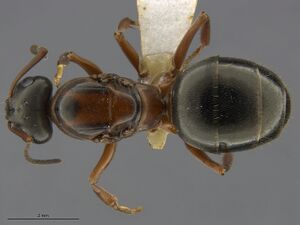 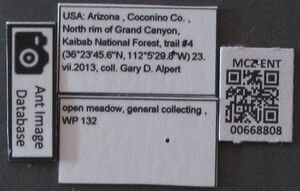
| |
| Queen. . | Owned by Museum of Comparative Zoology. |
Nomenclature
The following information is derived from Barry Bolton's Online Catalogue of the Ants of the World.
- neorufibarbis. Formica fusca var. neorufibarbis Emery, 1893i: 660 (w.) U.S.A. Forel, 1902i: 699 (q.); Wheeler, W.M. 1917a: 547 (m.); Wheeler, G.C. & Wheeler, J. 1953c: 165 (l.). Combination in F. (Serviformica): Emery, 1925b: 248. Subspecies of fusca: Wheeler, G.C. & Wheeler, E.W. 1944: 261. Raised to species: Creighton, 1950a: 537. Senior synonym of algida, gelida: Francoeur, 1973: 215.
- gelida. Formica fusca var. gelida Wheeler, W.M. 1913f: 399 (in key) (w.q.m.) U.S.A. [Formica fusca subsp. fusca var. gelida Wheeler, W.M. 1913f: 505; unavailable name.] Subspecies of fusca: Wheeler, W.M. 1917a: 546; of neorufibarbis: Creighton, 1950a: 537. Junior synonym of neorufibarbis: Francoeur, 1973: 215.
- algida. Formica fusca var. algida Wheeler, W.M. 1915f: 205 (w.q.) U.S.A. Combination in F. (Serviformica): Emery, 1925b: 248. Subspecies of neorufibarbis: Creighton, 1950a: 537. Junior synonym of neorufibarbis: Francoeur, 1973: 215.
Unless otherwise noted the text for the remainder of this section is reported from the publication that includes the original description.
Description
References
- Borowiec, M.L., Cover, S.P., Rabeling, C. 2021. The evolution of social parasitism in Formica ants revealed by a global phylogeny. Proceedings of the National Academy of Sciences 118, e2026029118 (doi:10.1073/pnas.2026029118).
- Boucher, P., Hébert, C., Francoeur, A., Sirois, L. 2015. Postfire succession of ants (Hymenoptera: Formicidae) nesting in dead wood of Northern Boreal Forest. Environmental Entomology 44, 1316–1327 (doi:10.1093/ee/nvv109).
- Carroll, T.M. 2011. The ants of Indiana (Hymenoptera: Formicidae). M.S. thesis, Purdue University.
- Creighton, W. S. 1950a. The ants of North America. Bulletin of the Museum of Comparative Zoology 104: 1-585 (page 537, Raised to species)
- de la Mora, A., Sankovitz, M., Purcell, J. 2020. Ants (Hymenoptera: Formicidae) as host and intruder: recent advances and future directions in the study of exploitative strategies. Myrmecological News 30: 53-71 (doi:10.25849/MYRMECOL.NEWS_030:053).
- Emery, C. 1893k. Beiträge zur Kenntniss der nordamerikanischen Ameisenfauna. Zool. Jahrb. Abt. Syst. Geogr. Biol. Tiere 7: 633-682 (page 660, worker described)
- Emery, C. 1925d. Hymenoptera. Fam. Formicidae. Subfam. Formicinae. Genera Insectorum 183: 1-302 (page 248, Combination in F. (Serviformica))
- Fairweather, A.D., Lewis, J.H., Hunt, L., Smith, M.A., McAlpine, D.F. 2020. Ants (Hymenoptera: Formicidae) of Rockwood Park, New Brunswick: An assessment of species richness and habitat. Northwestern Naturalist 27(3):576–584.
- Forel, A. 1902k. Descriptions of some ants from the Rocky Mountains of Canada (Alberta and British Columbia), collected by Edward Whymper. Trans. Entomol. Soc. Lond. 1902: 699-700 (page 699, queen described)
- Francoeur, A. 1973. Révision taxonomique des espèces néarctiques du groupe fusca, genre Formica (Formicidae, Hymenoptera). Mém. Soc. Entomol. Qué. 3: 1-316 (page 215, Raised to species, Senior synonym of algida and gelida)
- Higgins, R. J. and B. S. Lindgren. 2015. Seral changes in ant (Hymenoptera: Formicidae) assemblages in the sub-boreal forests of British Columbia. Insect Conservation and Diversity. 8:337-347. doi:10.1111/icad.12112
- Higgins, R.J., Lindgren, B.S. 2012. An evaluation of methods for sampling ants (Hymenoptera: Formicidae) in British Columbia, Canada. The Canadian Entomologist 144, 491–507 (doi:10.4039/tce.2012.50).
- Mackay, W. P. and E. Mackay. 2002. The ants of New Mexico (Hymenoptera: Formicidae). Edwin Mellen Press, Lewiston, NY.
- Siddiqui, J. A., Li, J., Zou, X., Bodlah, I., Huang, X. 2019. Meta-analysis of the global diversity and spatial patterns of aphid-ant mutualistic relationships. Applied Ecology and Environmental Research 17: 5471-5524 (doi:10.15666/aeer/1703_54715524).
- Waters, J.S., Keough, N.W., Burt, J., Eckel, J.D., Hutchinson, T., Ewanchuk, J., Rock, M., Markert, J.A., Axen, H.J., Gregg, D. 2022. Survey of ants (Hymenoptera, Formicidae) in the city of Providence (Rhode Island, United States) and a new northern-most record for Brachyponera chinensis (Emery, 1895). Check List 18(6), 1347–1368 (doi:10.15560/18.6.1347).
- West, M., Purcell, J. 2020. Task partitioning in ants lacking discrete morphological worker subcastes. Behavioral Ecology and Sociobiology 74 (doi:10.1007/S00265-020-02845-W).
- Wheeler, G. C. and J. Wheeler. 1986. The ants of Nevada. Natural History Museum of Los Angeles County, Los Angeles.
- Wheeler, G. C.; Wheeler, E. W. 1944. The ants of North Dakota. N. D. Hist. Q. 11: 231-271 (page 261, Subspecies of fusca)
- Wheeler, G. C.; Wheeler, J. 1953c. The ant larvae of the subfamily Formicinae. Ann. Entomol. Soc. Am. 46: 126-171 (page 165, larva described)
- Wheeler, W. M. 1917a. The mountain ants of western North America. Proc. Am. Acad. Arts Sci. 52: 457-569 (page 547, male described)
References based on Global Ant Biodiversity Informatics
- Allred D. M. 1982. Ants of Utah. The Great Basin Naturalist 42: 415-511.
- Allred, D.M. 1982. The ants of Utah. Great Basin Naturalist 42:415-511.
- Banschbach V. S., and E. Ogilvy. 2014. Long-term Impacts of Controlled Burns on the Ant Community (Hymenoptera: Formicidae) of a Sandplain Forest in Vermont. Northeastern Naturalist 21(1): 1-12.
- Beck D. E., D. M. Allred, W. J. Despain. 1967. Predaceous-scavenger ants in Utah. Great Basin Naturalist 27: 67-78
- Billick, I. 2002. The Relationship between the Distribution of Worker Sizes and New Worker Production in the Ant Formica neorufibarbis. Oecologia 132(2):244-249
- Blacker, N.C. 1992. Some Ants from Southern Vancouver Island, British Columbia. J. Entomol. Soc. Bri. Columbia 89:3-12.
- Blacker, N.C. 1992. Some ants (Hymenoptera: Formicidae) from Southern Vancouver Island, British Columbia. Journal of the Entomological Society of British Columbia 89:3-12
- Blades, D.C.A. and S.A. Marshall. Terrestrial arthropods of Canadian Peatlands: Synopsis of pan trap collections at four southern Ontario peatlands. Memoirs of the Entomological Society of Canada 169:221-284
- Borchert, H.F. and N.L. Anderson. 1973. The Ants of the Bearpaw Mountains of Montana (Hymenoptera: Formicidae). Journal of the Kansas Entomological Society 46(2):200-224
- Boucher P., C. Hebert, A. Francoeur, and L. Sirois. 2015. Postfire succession of ants (Hymenoptera: Formicidae) nesting in dead wood of northern boreal forest. Environ. Entomol. 44(5): 1316-1327: DOI: 10.1093/ee/nvv109
- Choate B., and F. A. Drummond. 2012. Ant Diversity and Distribution (Hymenoptera: Formicidae) Throughout Maine Lowbush Blueberry Fields in Hancock and Washington Counties. Environ. Entomol. 41(2): 222-232.
- Choate B., and F. A. Drummond. 2013. The influence of insecticides and vegetation in structuring Formica Mound ant communities (Hymenoptera: Formicidae) in Maine lowbush blueberry. Environ. Entomol. 41(2): 222-232.
- Cole A. C., Jr. 1936. An annotated list of the ants of Idaho (Hymenoptera: Formicidae). Canadian Entomologist 68: 34-39.
- Cole A. C., Jr. 1942. The ants of Utah. American Midland Naturalist 28: 358-388.
- Cole A. C., Jr. 1954. Studies of New Mexico ants. XI. The genus Formica with a description of a new species (Hymenoptera: Formicidae). Journal of the Tennessee Academy of Science 29: 163-167.
- Cole, A.C. 1936. An annotated list of the ants of Idaho (Hymenoptera; Formicidae). Canadian Entomologist 68(2):34-39
- Coovert, G.A. 2005. The Ants of Ohio (Hymenoptera: Formicidae) Ohio Biological Survey Bulletin New Series Volume 15(2):1-196
- Del Toro, I. 2010. PERSONAL COMMUNICATION. MUSEUM RECORDS COLLATED BY ISRAEL DEL TORO
- Drummond F. A., A. M. llison, E. Groden, and G. D. Ouellette. 2012. The ants (Formicidae). In Biodiversity of the Schoodic Peninsula: Results of the Insect and Arachnid Bioblitzes at the Schoodic District of Acadia National Park, Maine. Maine Agricultural and forest experiment station, The University of Maine, Technical Bulletin 206. 217 pages
- Ellison A. M., E. J. Farnsworth, and N. J. Gotelli. 2002. Ant diversity in pitcher-plant bogs of Massachussetts. Northeastern Naturalist 9(3): 267-284.
- Forel A. 1902. Descriptions of some ants from the Rocky Mountains of Canada (Alberta and British Columbia), collected by Edward Whymper. Transactions of the Entomological Society of London 1902: 699-700.
- Francoeur A., and R. R. Snelling. 1979. Notes for a revision of the ant genus Formica. 2. Reidentifications for some specimens from the T. W. Cook collection and new distribution data (Hymenoptera: Formicidae). Contr. Sci. (Los Angel.) 309: 1-7.
- Francoeur, A. 1983. The ant fauna near the tree-line in Northern Quebec (Formicidae, Hymenoptera). Nordicana 47: 177-180
- Francoeur, A. 1997. Ants (Hymenoptera: Formicidae) of the Yukon. Pages 901 910 in H.V. Danks and J.A. Downes (Eds.), Insects of the Yukon. Biological Survey of Canada (Terrestrial Arthropods), Ottawa.
- Francoeur. A. 1973. Revision taxonomique des especes nearctiques du group fusca, genre Formica. Memoires de la Societe Entomologique du Quebec 3: 1-316.
- Glasier J. R. N., S. E. Nielsen, J. Acorn, and J. Pinzon. 2019. Boreal sand hills are areas of high diversity for Boreal ants (Hymenoptera: Formicidae). Diversity 11, 22; doi:10.3390/d11020022.
- Glasier J. R. N., S. Nielsen, J. H. Acorn, L. H. Borysenko, and T. Radtke. 2016. A checklist of ants (Hymenoptera: Formicidae) of Saskatchewan. The Canadian Field-Naturalist 130(1): 40-48.
- Gotelli, N.J. and A.M. Ellison. 2002. Biogeography at a Regional Scale: Determinants of Ant Species Density in New England Bogs and Forests. Ecology 83(6):1604-1609
- Gregg R. E. 1969. Geographic distribution of the ant genus Formica (Hymenoptera: Formicidae). Proceedings of the Entomological Society of Washington 71: 38-49.
- Gregg, R.T. 1963. The Ants of Colorado.
- Ivanov K., L. Hightower, S. T. Dash, and J. B. Keiper. 2019. 150 years in the making: first comprehensive list of the ants (Hymenoptera: Formicidae) of Virginia, USA. Zootaxa 4554 (2): 532–560.
- Johnson R. Personnal Database. Accessed on February 5th 2014 at http://www.asu.edu/clas/sirgtools/resources.htm
- Knowlton G. F. 1970. Ants of Curlew Valley. Proceedings of the Utah Academy of Sciences, Arts and Letters 47(1): 208-212.
- La Rivers I. 1968. A first listing of the ants of Nevada. Biological Society of Nevada, Occasional Papers 17: 1-12.
- Lavigne R., and T. J. Tepedino. 1976. Checklist of the insects in Wyoming. I. Hymenoptera. Agric. Exp. Sta., Univ. Wyoming Res. J. 106: 24-26.
- Lidgren, B.S. and A.M. MacIsaac. 2002. A Preliminary Study of Ant Diversity and of Ant Dependence on Dead Wood in Central Interior British Columbia. USDA Forest Service Gen. Tech. Rep. PSW-GTR-181.
- Lindgren, B.S. and A.M. MacIsaac. 2002. Ant dependence on dead wood in Central Interior British Columbia. USDA Forest Service Gen. Tech. Rep.PSW-GTR-181
- Longino, J.T. 2010. Personal Communication. Longino Collection Database
- Lubertazi, D. Personal Communication. Specimen Data from Museum of Comparative Zoology at Harvard
- Mackay W. P., and E. E. Mackay. 2002. The ants of New Mexico (Hymenoptera: Formicidae). Lewiston, New York: Edwin Mellen Press, 400 pp.
- Mackay, W., D. Lowrie, A. Fisher, E. Mackay, F. Barnes and D. Lowrie. 1988. The ants of Los Alamos County, New Mexico (Hymenoptera: Formicidae). pages 79-131 in J.C. Trager, editor, Advances in Myrmecololgy.
- Mallis A. 1941. A list of the ants of California with notes on their habits and distribution. Bulletin of the Southern California Academy of Sciences 40: 61-100.
- Mann W. M. 1911. On some Northwestern ants and their guests. Psyche (Cambridge) 18: 102-109.
- Menozzi C. 1932. Formiche del Nord America raccolte dal Prof. F. Silvestri. Bollettino del Laboratorio di Zoologia Generale e Agraria della Reale Scuola Superiore d'Agricoltura. Portici. 26: 310-312.
- Merle W. W. 1939. An Annotated List of the Ants of Maine (Hymenoptera: Formicidae). Entomological News. 50: 161-165
- Nielsen M. G. 1987. The ant fauna (Hymenoptera: Formicidae) in northern and interior Alaska. A survey along the trans-Alaskan pipeline and a few highways. Entomological News 98:74-88
- O'Keefe S. T., J. L. Cook, T. Dudek, D. F. Wunneburger, M. D. Guzman, R. N. Coulson, and S. B. Vinson. 2000. The Distribution of Texas Ants. The Southwestern Entomologist 22: 1-92.
- Ouellette G. D., F. A. Drummond, B. Choate and E. Groden. 2010. Ant diversity and distribution in Acadia National Park, Maine. Environmental Entomology 39: 1447-1556
- Parson G. L., G Cassis, A. R. Moldenke, J. D. Lattin, N. H. Anderson, J. C. Miller, P. Hammond, T. Schowalter. 1991. Invertebrates of the H.J. Andrews Experimental Forest, western Cascade Range, Oregon. V: An annotated list of insects and other arthropods. Gen. Tech. Rep. PNW-GTR-290. Portland, OR: U.S. Department of Agriculture, Forest Service, Pacific Northwest Research Station. 168 p.
- Procter W. 1938. Biological survey of the Mount Desert Region. Part VI. The insect fauna. Philadelphia: Wistar Institute of Anatomy and Biology, 496 pp.
- Rees D. M., and A. W. Grundmann. 1940. A preliminary list of the ants of Utah. Bulletin of the University of Utah, 31(5): 1-12.
- Sharplin, J. 1966. An annotated list of the Formicidae (Hymenoptera) of Central and Southern Alberta. Quaetiones Entomoligcae 2:243-253
- Smith F. 1941. A list of the ants of Washington State. The Pan-Pacific Entomologist 17(1): 23-28.
- Smith M. R. 1952. On the collection of ants made by Titus Ulke in the Black Hills of South Dakota in the early nineties. Journal of the New York Entomological Society 60: 55-63.
- Talbot M. 1976. A list of the ants (Hymenoptera: Formicidae) of the Edwin S. George Reserve, Livingston County, Michigan. Great Lakes Entomologist 8: 245-246.
- Varady-Szabo, H. 2004. Spiders and Ants Associated with Fallen Logs in Forillon National Park of Canada, Quebec. Masters Thesis, MgGill University, Montreal, Canada
- Vásquez-Bolaños M. 2011. Lista de especies de hormigas (Hymenoptera: Formicidae) para México. Dugesiana 18: 95-133
- Wheeler G. C., J. N. Wheeler, and P. B. Kannowski. 1994. Checklist of the ants of Michigan (Hymenoptera: Formicidae). The Great Lakes Entomologist 26(4): 297-310
- Wheeler G. C., and E. W. Wheeler. 1944. Ants of North Dakota. North Dakota Historical Quarterly 11:231-271.
- Wheeler G. C., and J. Wheeler. 1986. The ants of Nevada. Los Angeles: Natural History Museum of Los Angeles County, vii + 138 pp.
- Wheeler G. C., and J. Wheeler. 1987. A Checklist of the Ants of South Dakota. Prairie Nat. 19(3): 199-208.
- Wheeler J. N., G. C. Wheeler, R. J. Lavigne, T. A. Christiansen, and D. E. Wheeler. 2014. The ants of Yellowstone National Park. Lexington, Ky. : CreateSpace Independent Publishing Platform, 2013. 112 pages.
- Wheeler W. M. 1906. The ants of the Grand Cañon. Bulletin of the American Museum of Natural History 22: 329-345.
- Wheeler W. M. 1913. A revision of the ants of the genus Formica (Linné) Mayr. Bulletin of the Museum of Comparative Zoology 53: 379-565.
- Wheeler W. M. 1915. A new bog-inhabiting variety of Formica fusca L. Psyche (Cambridge) 22: 203-206.
- Wheeler W. M. 1917. The ants of Alaska. Bulletin of the Museum of Comparative Zoology 61: 13-23.
- Wheeler W. M. 1917. The mountain ants of western North America. Proceedings of the American Academy of Arts and Sciences 52: 457-569.
- Wheeler, G.C. and J. Wheeler. 1978. Mountain ants of Nevada. Great Basin Naturalist 35(4):379-396
- Wheeler, G.C. and J. Wheeler. 1985. A checklist of Texas ants. Prairie Naturalist 17:49-64.
- Wheeler, G.C. and J. Wheeler. 1988. A checklist of the ants of Montana. Psyche 95:101-114
- Wheeler, G.C. and J. Wheeler. 1988. A checklist of the ants of Wyoming. Insecta Mundi 2(3&4):230-239
- Wheeler, G.C., J. Wheeler and P.B. Kannowski. 1994. CHECKLIST OF THE ANTS OF MICHIGAN (HYMENOPTERA: FORMICIDAE). Great Lakes Entomologist 26:1:297-310
- Wheeler, G.C., J. Wheeler, T.D. Galloway and G.L. Ayre. 1989. A list of the ants of Manitoba. Proceedings of the Entomological Society of Manitoba 45:34-49
- Wing M. W. 1939. An annotated list of the ants of Maine (Hymenoptera: Formicidae). Entomological News 50:161-165.
- Yensen, N.P., W.H. Clark and A. Francoeur. 1977. A checklist of Idaho Ants. The Pan-Pacific Entomologist 53:181-187
- Pages using DynamicPageList3 parser function
- North temperate
- North subtropical
- Ant Associate
- Host of Formica adamsi alpina
- Host of Formica aserva
- Host of Formica densiventris
- Host of Formica puberula
- Host of Formica rubicunda
- Host of Formica wheeleri
- Host of Polyergus bicolor
- Host of Polyergus mexicanus
- Host of Formica adamsi
- Aphid Associate
- Host of Aphis asclepiadis
- Host of Aphis salicariae
- Host of Aphis varians
- Host of Rhopalosiphum nymphaeae
- Cricket Associate
- Host of Myrmecophilus nebrascensis
- Eucharitid wasp Associate
- Host of Eucharis sp.
- ''Microdon'' fly Associate
- Host of Microdon albicomatus
- Host of Microdon piperi
- Species
- Extant species
- Formicidae
- Formicinae
- Formicini
- Formica
- Formica neorufibarbis
- Formicinae species
- Formicini species
- Formica species
- Need Body Text
- Fusca group


